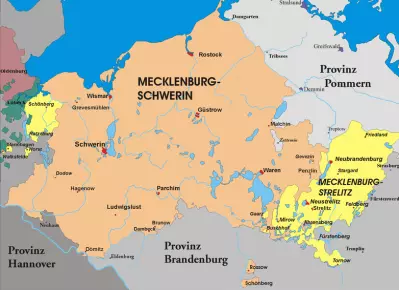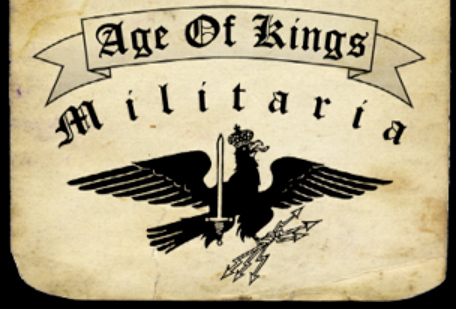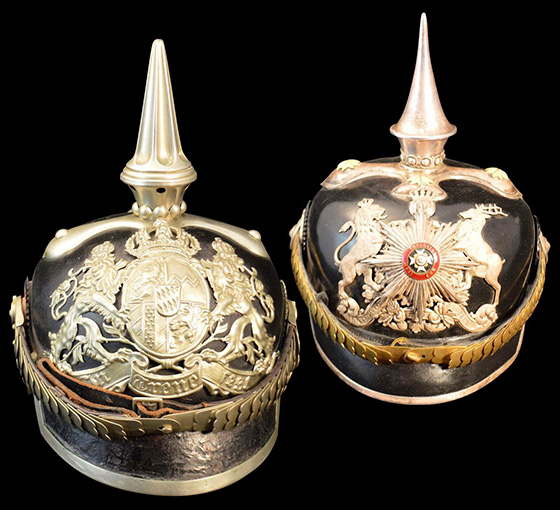Mecklenburg - Schwerin
Grand Duchy of Mecklenburg-Schwerin.


The Grand Duchy of Mecklenburg-Schwerin was a territory in Northern Germany held by the House of Mecklenburg residing at Schwerin. The Grand Duchy was bounded by the Baltic Sea in the north and the Prussian province of Pomerania in the northeast, where the border with the Prussian province of Lower Pomerania (formerly Swedish Pomeranian). In the south it bordered with the Prussian province of Brandenburg and in the southwest the Kingdom of Hanover, which was incorporated into the Prussian province of Hanover after the Austro-Prussian War in 1866. Mecklenburg was almost entirely surrounded by Prussian territory. (see map).
In 1867, Mecklenburg-Schwerin joined the North German Confederation and the Zollverein. In the Franco-Prussian War (1870–1871), Prussia again received valuable assistance from Grand Duke Frederick Francis II, who was an ardent advocate of German unity and held a high command in the Prussian army. In the course of the Unification of Germany in 1871, Mecklenburg-Schwerin and Mecklenburg-Strelitz became states of the German Empire. After the 1866 War, Mecklenburg Schwerin military units were placed under command of the Prussian Army.
Mecklenburg Schwerin 89th Grenadier Regt. I & III Btl and 90th Fusilier Regt

The newly integrated regiments were titled :
- Grand Ducal Mecklenburg Grenadier Regiment Nr. 89, 1st and 3rd Batl.
- Grand Ducal Mecklenburg Fusilier Regt. Nr. 90 – Kaiser Wilhelm Rgt.
In order to begin full integration of the military units into the greater Prussian Contingent Army, the Mecklenburg Schwerin Army adopted a Prussian style pickelhaube in 1868. They were however permitted to have several unique distinguishing characteristics. The front helmet plate was the multi-pointed gold rising star on which was placed in the center, the silver Heraldic Arms Mecklenburg Schwerin. The Grand Duchy retained use of the Blue/Yellow/Red state Land cockade on the left side of the helmet. Instead of the standard pointed spike the Mecklenburg Schwerin contingent adopted a fluted spike with ball top like the one used by the Prussian Customs Police Officers. This fluted ball top remained in use until 1895, when the units adopted the standard Prussian style base with plain fluted spike. The 89th Grenadier Regt. 1st and 3rd Battalions were allowed to wear a Black Horse Hair plume for parades (red plumes for musicians). The 90th Fusilier Regiment did not wear a parade plume. Thus an EM helmet for the 89th Regiment must have a removable spike to be correct. 90th Fusilier EM helmet should have a non-removable spike.

Mecklenburg Schwerin units followed the style changes introduced by the Prussian Army. In 1891 the 89th Grenadier Regiment 1st and 3rd battalions Enlisted Model helmets adopted the M91 side lug and flat chinscales. The 90th Fusilier Regiment adopted the M91 side lug but opted for use of the leather M91 chinstrap. The National (Reichs) cockade was introduced in 1897 for all units of the Imperial German Army and worn on the right side of the helmet.
After the start of World War I the introduction of the Model 1915 field gray helmet for Enlisted Men (issue) helmets and the Model 1916 helmet for officers were adopted by Mecklenburg Schwerin. The early filed gray EM helmets had M15 removable fluted spikes. As the war progressed, it was increasingly the hard to make fluted spike. It was later replaced by the standard non-fluted spike top.




